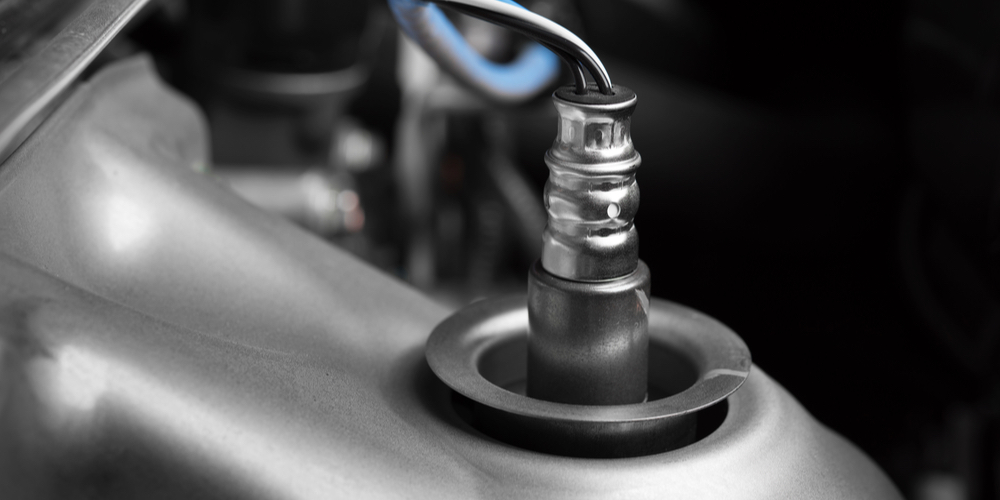Ever wondered why your check engine light is on and your car’s running rough? It might be due to a P0040 code.
This diagnostic trouble code indicates that your vehicle’s computer thinks the oxygen sensor signals from Bank 1 Sensor 1 and Bank 2 Sensor 1 have been swapped. The P0040 code is set when the Powertrain Control Module (PCM) detects that the wiring harnesses from these sensors have been crossed.

You might be scratching your head, wondering what all this bank and sensor talk means. Don’t worry, we’ve got you covered.
Bank 1 always includes cylinder #1, while Bank 2 is on the opposite side.
Sensor 1 refers to the oxygen sensor before the catalytic converter.
When these signals get mixed up, it’s like your car’s brain is getting conflicting information about the air-fuel mixture.
This mix-up can happen due to a few reasons.
Maybe there was some recent work done on your exhaust system, or perhaps there’s some damage to the wiring.
Whatever the cause, it’s important to address this issue promptly to keep your engine running smoothly and efficiently.
Key Takeaways
- The P0040 code indicates swapped oxygen sensor signals between Bank 1 Sensor 1 and Bank 2 Sensor 1.
- Common causes include misrouted wiring, damaged sensors, or recent exhaust work.
- Proper diagnosis and repair are crucial for maintaining engine performance and fuel efficiency.
Decoding the P0040 Trouble Code
The P0040 code can be a head-scratcher, but don’t worry – we’re about to unravel this automotive mystery together.
Let’s dive into what this pesky code means and why your car’s computer might be getting its wires crossed.
Understanding the Code
P0040 is like your car’s way of saying, “Hey, something’s not quite right with my oxygen sensors!” This trouble code indicates that the oxygen sensor signals have been swapped between Bank 1 Sensor 1 and Bank 2 Sensor 1. It’s as if your car’s left and right hands are suddenly speaking each other’s language!
Your vehicle’s computer, the PCM, is a bit of a control freak.
When it detects that these important sensors are giving mixed signals, it throws up the P0040 code.
This usually happens when the wiring harnesses from these sensors have decided to play musical chairs.
Differences in Bank 1 and Bank 2
Now, you might be wondering, “What’s all this bank business about?”
Well, in the world of engines, banks are like neighborhoods for cylinders. Bank 1 is extra special because it always includes cylinder #1. It’s like the VIP section of your engine.
Bank 2, on the other hand, is home to the other half of your cylinders. In a V6 or V8 engine, you’ve got two cozy banks of cylinders facing each other. Each bank has its own oxygen sensor keeping tabs on the exhaust.
When these sensors start reporting to the wrong bank, your engine’s performance can go haywire. It’s like sending your utility bills to your neighbor’s house – things are bound to get messy!
Symptoms of a P0040 Code

When your car’s computer gets its wires crossed, it’s like your mechanic trying to diagnose your engine while wearing a blindfold. You might notice a few quirky behaviors that signal something’s amiss under the hood.
Recognizing Common Signs
Your trusty steed might start acting up in ways you can’t ignore.
You’ll feel a rough idle that makes your car shake like it’s got the jitters. It’s as if your engine had one too many espressos!
Your fuel efficiency could take a nosedive faster than a skydiver without a parachute. Suddenly, you’re visiting the gas station more often than your favorite coffee shop.
You might also notice your engine’s power isn’t what it used to be. It’s like trying to run a marathon in flip-flops – you’re just not getting the oomph you need.
When the Check Engine Light Shines
That pesky check engine light might decide to crash your party. It’s like your car’s way of saying, “Hey, pay attention to me!”
Don’t ignore it like you do those spam calls about your car’s extended warranty.
This light is your first clue that your oxygen sensors might be playing musical chairs.
Remember, your car’s not trying to punk you. It’s just its way of saying, “I need a little TLC.” So, when that light pops on, it’s time to put on your detective hat and figure out what’s going on under the hood.
Troubleshooting and Diagnostics

Diagnosing a P0040 code requires some detective work and the right tools. You’ll need to put on your mechanic’s hat and get ready to dig into your vehicle’s electrical system.
Using Advanced Scan Tools
Got a fancy scan tool? Now’s the time to put it to work.
These high-tech gadgets can help you pinpoint where those pesky O2 sensor signals got swapped.
Hook up your scanner and watch the live data stream.
You’re looking for any funky readings from Bank 1 Sensor 1 and Bank 2 Sensor 1.
If the values seem backwards, you’ve hit the jackpot.
Remember, your car’s computer is pretty smart. It’s expecting certain patterns from these sensors. When things get mixed up, it throws a fit (and a code).
Performing a Continuity Test
Time to break out the multimeter, folks! A continuity test is your best friend when hunting down wiring issues.
First, disconnect the O2 sensor connectors.
Now, test the continuity between the sensor wires and the ECU connector. Any breaks in the circuit? That’s your culprit.
Don’t forget to check for shorts too. You don’t want those wires playing footsie under the hood. A short circuit can cause all sorts of mischief, including swapped signals.
Visual Inspection Wisdom
Sometimes, the simplest solution is the best. Get your flashlight and start looking. You’re searching for any signs of damage to the wiring harness.
Check for frayed wires, melted insulation, or loose connections.
Pay extra attention to areas near hot exhaust components. Heat and wires don’t always play nice together.
Look for any recent repairs too. Sometimes a well-meaning mechanic might accidentally cross wires during other work. It happens to the best of us!
Remember, patience is key. Take your time and be thorough. Your keen eye might just save you a bundle on unnecessary parts replacements.
Understanding Oxygen Sensor Operation
Oxygen sensors play a crucial role in your vehicle’s engine management system. These nifty little devices help keep your car running smoothly and efficiently while also keeping Mother Nature happy.
Role in Fuel Efficiency
You might think of oxygen sensors as tiny sniffers in your exhaust system. They’re constantly on the lookout for excess oxygen, which can indicate an inefficient fuel mixture.
When they detect too much oxygen, they send a signal to your car’s computer to add more fuel.
On the flip side, if there’s not enough oxygen, your car will reduce the fuel flow.
This constant dance of adjusting the air-fuel mixture helps your engine run at peak efficiency.
It’s like having a personal chef for your car, always tweaking the recipe for the perfect performance dish.
Without these sensors, you’d be burning through fuel faster than a teenager with their first credit card at a mall. They’re the unsung heroes of fuel economy, helping you squeeze every last mile out of each gallon.
Oxygen Sensor and Emissions
When it comes to emissions, oxygen sensors are like the hall monitors of your exhaust system. They keep a watchful eye on the gases coming out of your tailpipe, making sure everything’s up to snuff.
These sensors work hand-in-hand with your catalytic converter, ensuring it’s doing its job of scrubbing those nasty pollutants.
If the oxygen levels aren’t quite right, your car might start pumping out more harmful emissions than a steam engine from the 1800s.
By maintaining the proper air-fuel ratio, oxygen sensors help reduce emissions and keep your car running cleanly.
They’re like the eco-warriors of your engine, fighting the good fight against pollution one exhaust cycle at a time.
Repair Guidelines
Fixing swapped oxygen sensor signals requires careful diagnosis and targeted repairs. Let’s break down the key steps for DIY mechanics and when it’s best to call in the pros.
Do-It-Yourself Tips
First things first, grab your trusty OBD2 scanner and confirm that P0040 is indeed the culprit. Now, time to roll up those sleeves!
Start by inspecting the wiring harness connecting your O2 sensors. Look for any obvious cross-connections or damage.
If you spot swapped connectors, you’re in luck – simply disconnect and reconnect them correctly.
No visible issues? Time to break out the multimeter.
Test the continuity of each wire from the sensor to the PCM. You might find a sneaky short circuit causing the mix-up.
Repair difficulty: Moderate. It’s not rocket science, but you’ll need some patience and basic electrical know-how.
When to Visit the Pro
If your DIY attempts leave you scratching your head, it’s time to wave the white flag.
A professional mechanic has the tools and expertise to tackle trickier issues.
They can perform advanced diagnostics to rule out PCM failure, which could be mimicking swapped signals.
They’ll also have access to manufacturer-specific wiring diagrams to trace any elusive shorts.
Remember, messing with O2 sensors can impact your engine’s performance and emissions. If you’re not 100% confident, let the pros handle it.
Your wallet might grumble now, but your car will thank you later!
Frequently Asked Questions
Diagnosing oxygen sensor issues can be tricky, but we’ve got you covered.
Let’s dive into some common questions about O2 sensor codes and how to troubleshoot them.
How can I tell if I’ve mixed up Bank 1 Sensor 1 with Bank 2 Sensor 1?
You might have a wiring swap if your engine runs rough or your fuel economy takes a nosedive.
The easiest way to check is to inspect the wiring harnesses for any recent work or damage.
If you’re feeling brave, you can disconnect and reconnect the sensors one at a time.
Just remember, lefty-loosey, righty-tighty!
Can a faulty O2 sensor throw a P0420 code for the catalytic converter?
You betcha! A wonky O2 sensor can make your car think the cat’s gone bad.
Before you shell out big bucks for a new catalytic converter, double-check those oxygen sensors.
They’re like the tattletales of your exhaust system – if they’re lying, your PCM might get the wrong idea.
Is there a way to test if my O2 sensor Bank 1 Sensor 2 is functioning correctly?
Grab yourself a multimeter and get ready to play detective.
You’ll want to check the voltage output of the sensor while the engine’s running.
A good O2 sensor should fluctuate between 0.1 and 0.9 volts. If it’s stuck or lazy, you might have found your culprit.
What are the common troubleshooting steps for a P0030 code?
First, check those wiring harnesses like you’re looking for the last cookie in the jar.
Next, inspect the heater circuit – it might be taking an unwanted vacation.
If all else fails, it might be time to say goodbye to your old O2 sensor and welcome a shiny new one.
Can using the wrong O2 sensor impact the P0050 code diagnosis?
You bet your dipstick it can! Using the wrong O2 sensor is like trying to fit a square peg in a round hole.
It might look right, but it won’t work right.
Always double-check that you’ve got the correct sensor for your make and model. Your engine (and wallet) will thank you.
What other symptoms might I notice if I have a P0041 code aside from the check engine light?
Keep your eyes peeled for a drop in fuel economy – your car might start drinking gas like it’s going out of style.
You might also notice some hesitation or rough idling.
In extreme cases, you could even fail an emissions test.
Nobody wants to be that guy at the DMV, trust me.
